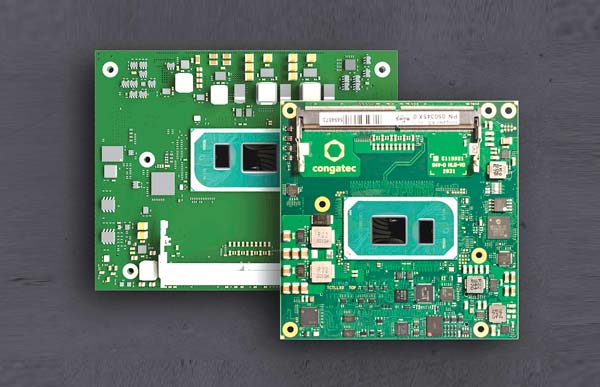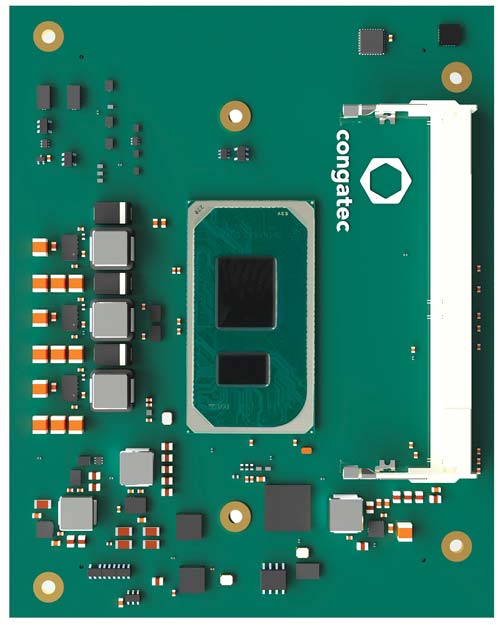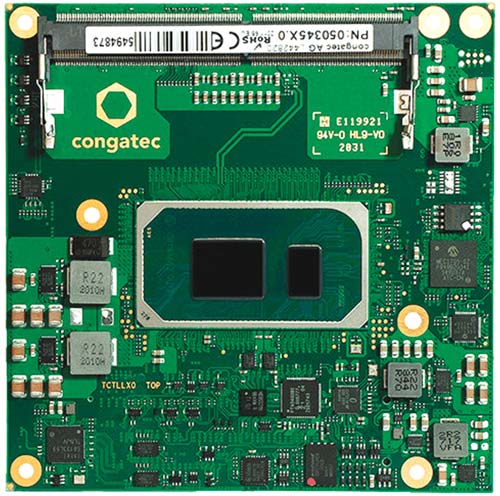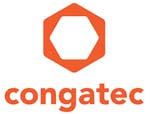 It’s a new era for high-end embedded processors that are now available on two Computer-on-Module form factors: The brand-new COM-HPC® Client and COM Express® Type 6. With the emergence of the 11th Gen Intel® Core® processor generation (codenamed Tiger Lake), developers now have the ability to choose the most appropriate form factor that best suits their project requirements.
It’s a new era for high-end embedded processors that are now available on two Computer-on-Module form factors: The brand-new COM-HPC® Client and COM Express® Type 6. With the emergence of the 11th Gen Intel® Core® processor generation (codenamed Tiger Lake), developers now have the ability to choose the most appropriate form factor that best suits their project requirements.
Considerations and Concerns
Up until today, COM Express had monopolized the high-end embedded computing field for designs based on Computer-on-Modules. However, as COM-HPC surfaced, customers started to have numerous questions concerning their upcoming high-end embedded projects. To begin with, the first obvious quandary for them is understanding which processor they should leverage. Nevertheless, this issue is easy to resolve since today, and for the first time in many years, the 11th Gen Intel® Core® processor generation (codenamed Tiger Lake) high-end embedded processors are available on two Computer-on-Module form factors: COM-HPC® Client and COM Express® Type 6.
Second of all, the existence of both form factors makes designers (especially those who have been using COM Express up to this point) wonder if they should adjust their current COM Express investments or upgrade instead to a new module standard and carrier board design. In fact, these are only the first few of many questions that come to mind. Designers also began reflecting on other pressing issues like: How realistic is it that COM-HPC could make COM Express outdated? If so, to what extent will users be able to find COM Express modules? Would an immediate shift to COM-HPC be required? What kind of an impact would this module change to COM-HPC have on OEMs, their customers, and the competitors? Therefore, to address these concerns, a thorough exploration of COM-HPC is needed so designers can conclusively understand how these new modules work and what differentiates them from the COM Express Type 6 modules.
Comparing and Contrasting COM Express Basic and COM-HPC Size A

A few factors differentiate the COM-HPC Client from the COM Express Type 6 like: The number and bandwidth of PCIe lanes, Ethernet interfaces, and USB ports. Moreover, another distinguishing feature is that only the COM-HPC Client is supplemented with further remote management support (details available upon request).
Much like COM Express, the COM-HPC Client form factor is a Computer-on-Module standard by the PICMG. The guidelines additionally define specific COM-HPC Server modules; however, those modules will not be discussed in this article as they are headless and server-oriented. COM-HPC Client modules on the other hand, like COM Express Type 6 modules, support graphics. COM-HPC Client modules are available in three footprints: 120 mm x 160 mm (Size C), 120 mm x 120 mm (Size B), and 120 mm x 95 mm (Size A). Hence, COM-HPC size A is practically the same as COM Express Basic with its 125 mm x 95 mm dimensions. Yet, the 95 mm x 95 mm COM Express Compact is almost 21% more compact. Therefore, upgrading from COM Express Basic to COM-HPC Size A is an effortless task as the former is only 4% larger than the latest module. The bigger Size B and Size C COM-HPC Client modules, however, cover an even higher performance class above COM Express Type 6 modules and cater to the needs of high-performance applications that are not compatible with COM Express.

Much like its COM Express counterpart, the COM-HPC Client is available in three unique footprints. Since COM-Express is only slightly smaller than COM-HPC Client Size A, users can easily upgrade from the first to the latter.
As for the users who have been relying on COM Express Basic for their designs, they can always select the COM-HPC Client Size A form factor. It’s worth mentioning, though, that no COM-HPC Client option exists for the COM Express Compact size design. Accordingly, this clearly proves how the two factors are meant to supplement – rather than override – each other.
COM-HPC’s Higher Thermal Design Power
In addition to their bigger footprint sizes, COM-HPC modules can support higher power budgets than COM Express. Given that the Thermal Design Power (TDP) of COM-HPC modules can reach up to 200 watts, its power envelope is almost twice as high as that of COM Express Type 6, which cannot exceed 137 watts TDP. This makes COM-HPC’s TDP a whopping 46% higher. Hence, any user looking for a stronger processor power (which leads to a higher TDP) that COM Express is not currently able to support must consider making the shift to COM-HPC.
That said, COM-HPC Size A modules like the latest 15-watt conga-HPC/cTLU along with the 11th Intel Core processor generation will operate at the comparable CPU performance range as that of earlier COM Express modules. Furthermore, and as discussed in the next section, developers will find it greatly useful that COM-HPC has almost twice the number of signal pins, thereby ensuring a significantly larger bandwidth than the one COM Express Type 6 is currently able to offer.
COM-HPC’s Increased Number of Signal Pins & Bandwidth
COM Express Basic Type 6 and COM-HPC Client Size A are also dissimilar with regards to the connector and number of signal pins securing the module to the carrier board. While both COM Express and COM-HPC have two connectors, each COM-HPC connector has 400 pins while each COM Express connector has only 220 pins. This enormous addition in the case of COM-HPC results in a total of 800 signal pins that smoothly facilitate the connection of almost 80% more interfaces.
Moreover, since the COM-HPC connector is engineered for high-speed interfaces, it works well with high clock rates of PCIe 5.0 and 25 Gb/s Ethernet. On the other hand, because the connector is a major constraint for COM Express, it is suitable for interfaces up to PCIe Gen 3.0 and PCIe 4.0 in compatibility mode. However, there are efforts to replace the COM Express connector with one that is mechanically fully compatible but electronically more powerful and compatible with PCIe 4.0. Once this goal becomes a reality, it will certainly pave the way for many other innovations involving COM Express.
The Relation between Footprints and RAM Capacity

The conga-HPC/cTLU COM-HPC Size A module requires a newly-designed carrier board. The COM-HPC evaluation board is likely to be ready for sale and distribution in the near future.
Both COM-HPC and COM Express rely on SO-DIMMs (soldered memory) for their RAM capacity. To date, the RAM capacity of COM Express Basic has been proven to reach almost 128 Gbytes. As a result, and because both form factors have footprints that are nearly identical, the RAM capacity for COM-HPC Size A should also be (more or less) the same as well. If users need additional RAM, they have to rely on larger form factors. In fact, the larger COM Express extended form factor had virtually no relevance. So, larger modules will be based on the COM-HPC standard.
All this will take place in the new future as COM-HPC Server modules can cater to RAM needs reaching up to the mid-performance server class that is almost always in need of more memory. In addition, the modules would allow the integration of eight SO-DIMM memory modules, thereby offering up to 1.0 Terabyte of RAM.
Hence, even though the COM-HPC Client Size A module can supply more memory than the latest Tiger Lake UP3 COM Express Type 6 Compact, additional RAM capacity is not being exploited for the current module. In fact, Size A and Type 6 both provide two SO-DIMM sockets for 3200 MT/s and 32 GB DDR4, culminating in a total of 64 GB RAM. However, developers cannot fully benefit from the increased memory capacity of the larger COM-HPC form factors because the Tiger Lake UP3 is not able to handle more. To be more specific, requiring more RAM would undoubtedly create the need for a form factor that is bigger than the available COM Express Basic or COM HPC Size A modules. Nevertheless, with the constant advancements taking place related to memory density, it is very unlikely for RAM capacity to become a hinderance to targeted multi-purpose applications.
Graphics and Audio Support
Since COM-HPC Client and COM Express Type 6 can handle up to four displays facilitated by three digital display interfaces (DDI) and one embedded DisplayPort (eDP), the graphics support offered by the Client form factor is equivalent to that of Type 6.
Earlier COM Express modules were fully equipped with an HDA interface; however, with multimedia interfaces, COM-HPC is able to replace this past interface with SoundWire: The new MIPI standard. SoundWire needs just two lines and operates at rates reaching up to 12.288 Mhz. Furthermore, the standard can support up to four audio codecs in parallel on these two lines, with each codec having its own unique ID to enable evaluation. This is a significant breakthrough for applications that also rely on sound features.
Compatibility with PCIe Gen 4 and GbE beyond 1b Gigabit Bandwidth
COM-HPC Client has almost twice as many PCle lanes as COM Express Type 6: While the latter accommodates up to 24 PCIe lanes, the former is able to provide 49 PCle lanes. It is important to note that one PCIe lane of COM-HPC Client is exclusively dedicated to communicating with the Board Management Controller (BMC) of the carrier board.
The COM-HPC Client standard additionally supports two 25 GbE KR and up to two 10 GbE BaseT Ethernet interfaces. However, all the capabilities of this standard have not been fully unlocked yet by the current (11th) Intel Core processor generation. On the other hand, COM Express Type 6 can only handle a maximum of 1×1 GbE off the module; although, more network interfaces can be connected through PCIe and controlled from the carrier board.
Therefore, since the two form factors rely on a PCIe x4 Gen 4 interface, the resulting high bandwidth connections to peripherals is exactly the same for both. Moreover, developers can also leverage 8x PCIe Gen 3.0 x1 lanes with either module. Therefore, at least at the processor level, there is no difference. That said, the distinction only becomes apparent with GbE as the COM-HPC modules support 2x 2.5 GbE native connectivity, and COM Express modules allow 1x GbE natively. Consequently, the developers of COM Express have to invest in the components required for the carrier board in order to match the GbE performance of COM-HPC modules.
Lastly, both COM-HPC and COM Express Type 6 modules are compatible with Time-Sensitive Networking (TSN) for real-time communication via Ethernet. Accordingly, besides the fact that 2.5 GbE is a COM-HPC feature only, there are no major points of contrast with regards to PCIe and GbE.
High USB Bandwidth and MIPI-CSI Interface Support

The conga-TC570 COM Express Compact module, along with its integrated Intel Tiger Lake UP3 processor, is considered a turnkey product as it can be directly placed (plug & play) on current COM Express carrier boards that support either COM Express Basic or Compact.
The COM-HPC standard is specifically designed to support high speed interfaces. As such, the COM-HPC Client modules can accommodate up to 4x USB 4.0 interfaces and 4x USB 2.0 proving. COM Express Type 6 modules, however, can handle up to 4x USB 3.2 and 8x USB 2.0. Notwithstanding that COM-HPC has four less USB 2.0 ports than COM Express Type 6 modules, the Client is still able to offer a larger bandwidth as the USB 4.0 transfer rate is 40 Gbps.
Moreover, COM-HPC can natively integrate up to two MIPI-CSI interfaces. These two interfaces are simultaneously economical and compatible with cameras crucial for running numerous applications and facilitating 3D vision. Modules supporting two independent cameras are very versatile and can be utilized for multiple purposes including but not limited to: user identification, gesture control, augmented reality for maintenance, video surveillance and optical quality assurance, situational awareness for autonomous vehicles, and collaborative robotics. Hence, the fact that COM-HPC provides MIPI-CSI interface support gives it an advantage over COM Express Type 6. To date, the conga-HPC/cTLU model is able to support these two MIPI-CSI interfaces. In fact, the conga-HPC/cTLU also offers (besides the x86 instruction set afforded in Tiger Lake UP3) AI/DL instruction sets, Vector Neural Network Instructions (VNNI) support, and additionally features up to 96 execution units provided by the integrated Intel Xe graphics (Gen 12).
COM-HPC additionally allows 2x SATA interfaces to connect traditional SSDs and HDDs, as well as industrial interfaces like 2x UART and 12x GPIO. Finally, 2x I2C, SPI and eSPI complete this feature set. That said, while these COM-HPC Client features are comparable to COM Express Type 6, CAN bus support is only possible with Type 6 modules.
Upgrading to COM-HPC Client: Urgent or Unnecessary?
Having meticulously compared and contrasted COM-HPC client and COM Express Type 6, it becomes clear that COM Express will be the ideal platform for most designs for a minimum of another 3-5 years. This is largely because COM-HPC Client does not introduce a completely new system bus. While earlier changes included shifting from ISA to PCI and from PCI to PCI Express, with COM-HPC, specifying a new pinpoint was crucial. Another important detail to remember is the fact that it wasn’t until 2012 that COM Express finally superseded ETX by becoming the best-selling module standard. This happened almost 11 years after the launch of ETX, and 7 years after the launch of COM Express; and despite all that, ETX modules still did not become obsolete! Lastly, PCIe generations are backwards compatible and allow PCIe Gen 3.0 designs to have a durable shelf life – long after PCIe Gen 4.0 is set up across all processor levels. Therefore, if the bandwidths and interface specifications of a given design satisfy the standard requirements, it is absolutely unnecessary to upgrade to the COM-HPC Client module.
The Users of COM-HPC
On the other hand, the users who absolutely must opt for COM-HPC are those who would need certain specific interfaces supported by the modules. These interfaces are: full USB 4.0 bandwidth, 2.5 GbE, SoundWire, and/or MIPI-CSI today. In fact, anyone seeking higher-performance PCIe or Ethernet interfaces with up to 25 GbE must also give serious consideration to COM-HPC. Moreover, developers of high-performance systems should keep in mind that it is far simpler to scale down a design within a chosen standard than wait for performance increases of another standard that may never even happen in the first place. While this has been the driving rationale for all innovations involving COM-HPC, it is also balanced by the equally effective motto of “Never change a running system.”
Edge Server Module Remote Management Forthcoming
To make the COM-HPC launch all the more special, the PICMG Remote Management Subcommittee is also working on designing an extended remote management interface with the goal of creating a simplified version of the complex Intelligent Platform Management Interface (IPMI) specification to support the remote management of edge server modules. If successful, the new set will allow OEMs and users to ensure server-grade reliability, availability, maintainability, and security (RAMS). Furthermore, the addition of a board management controller on the carrier board helps to extend remote management serviceability to individual carrier board and further system demands as needed. This way, OEMs can be equipped with a stable basis for remote management that they can later adjust whenever they want to as their needs and priorities inevitably change.
Conclusion
In a perpetually advancing and highly digital age, COM Express shows a lot of promise at the performance level. However, the High-Performance Computing COM-HPC modules also accommodate a wide array of newly emerging compute-intensive applications, which require the processing of bandwidth-intensive data streams in a compact edge device. For more info regarding congatec’s 11th Gen Intel Core processors based embedded computers, browse the main landing page: https://congatec.com/11th-gen-intel-core/

Author:
Christian Eder, Director Marketing at congatec
and Chairman of the PICMG COM-HPC Subcommittee
congatec

congatec is a rapidly growing technology company focusing on embedded and edge computing products. The high-performance computer modules are used in a wide range of applications and devices in industrial automation, medical technology, transportation, telecommunications and many other verticals. congatec is the global market leader in the computer-on-modules segment with an excellent customer base from start-ups to international blue chip companies. Founded in 2004 and headquartered in Deggendorf, Germany, the company reached sales of 126 million US dollars in 2019. More information is available on our website at www.congatec.com or via LinkedIn, Twitter and YouTube.


